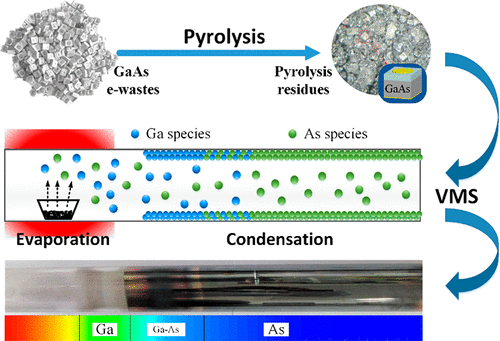当前位置:
X-MOL 学术
›
ACS Sustain. Chem. Eng.
›
论文详情
Our official English website, www.x-mol.net, welcomes your feedback! (Note: you will need to create a separate account there.)
Recycle Gallium and Arsenic from GaAs-Based E-Wastes via Pyrolysis–Vacuum Metallurgy Separation: Theory and Feasibility
ACS Sustainable Chemistry & Engineering ( IF 8.4 ) Pub Date : 2017-11-28 00:00:00 , DOI: 10.1021/acssuschemeng.7b03689 Lu Zhan 1 , Fafa Xia 1 , Yuhan Xia 1 , Bing Xie 1
ACS Sustainable Chemistry & Engineering ( IF 8.4 ) Pub Date : 2017-11-28 00:00:00 , DOI: 10.1021/acssuschemeng.7b03689 Lu Zhan 1 , Fafa Xia 1 , Yuhan Xia 1 , Bing Xie 1
Affiliation

|
This work proposed a novel method of pyrolysis and vacuum metallurgy to recycle gallium and arsenic from GaAs-based e-wastes, which may cause arsenic contamination and gallium waste if treated improperly. As a typical GaAs-based e-waste, the light-emitting diode (LED) was studied in this paper. Pure GaAs chips were first adopted to study the vacuum separation behavior of gallium and arsenic. Then, GaAs chips and packaging materials were mixed together to study the effect of packaging material pyrolysis on the subsequent vacuum metallurgy separation behavior of GaAs chips. This indicated that gallium and arsenic can be recycled efficiently at the heating temperature of 1273 K, the holding time of 60 min, and the vacuum pressure of ∼20 Pa, and the total recovery efficiency can reach 95 wt %. The recovered gallium and arsenic were condensed and collected in respective zones. However, because of the effect of organic material pyrolysis, some gallium was oxidized as gallium oxides, while arsenic was influenced little. This study will reveal the speciation transformation of gallium and arsenic during vacuum heat treatment, which can provide the theoretical foundation for recycling gallium and arsenic from LEDs and other GaAs-based e-wastes through pyrolysis and vacuum metallurgy separation.
中文翻译:

通过热解-真空冶金分离从基于GaAs的电子废物中回收镓和砷:理论和可行性
这项工作提出了一种热解和真空冶金的新方法,可以从基于GaAs的电子废物中回收镓和砷,如果处理不当,可能会导致砷污染和镓废物。作为一种典型的基于GaAs的电子废物,本文研究了发光二极管(LED)。首先采用纯GaAs芯片研究镓和砷的真空分离行为。然后,将GaAs芯片和包装材料混合在一起,以研究包装材料热解对随后的GaAs芯片真空冶金分离行为的影响。这表明,在1273 K的加热温度,60分钟的保持时间和约20 Pa的真空压力下,镓和砷可以有效地循环利用,总回收率可以达到95 wt%。将回收的镓和砷冷凝并收集在各个区域中。但是,由于有机物热解的作用,一些镓被氧化为氧化镓,而砷的影响很小。这项研究将揭示真空热处理过程中镓和砷的形态转变,这可以为通过热解和真空冶金分离从LED和其他基于GaAs的电子废物中回收镓和砷提供理论基础。
更新日期:2017-11-28
中文翻译:

通过热解-真空冶金分离从基于GaAs的电子废物中回收镓和砷:理论和可行性
这项工作提出了一种热解和真空冶金的新方法,可以从基于GaAs的电子废物中回收镓和砷,如果处理不当,可能会导致砷污染和镓废物。作为一种典型的基于GaAs的电子废物,本文研究了发光二极管(LED)。首先采用纯GaAs芯片研究镓和砷的真空分离行为。然后,将GaAs芯片和包装材料混合在一起,以研究包装材料热解对随后的GaAs芯片真空冶金分离行为的影响。这表明,在1273 K的加热温度,60分钟的保持时间和约20 Pa的真空压力下,镓和砷可以有效地循环利用,总回收率可以达到95 wt%。将回收的镓和砷冷凝并收集在各个区域中。但是,由于有机物热解的作用,一些镓被氧化为氧化镓,而砷的影响很小。这项研究将揭示真空热处理过程中镓和砷的形态转变,这可以为通过热解和真空冶金分离从LED和其他基于GaAs的电子废物中回收镓和砷提供理论基础。


























 京公网安备 11010802027423号
京公网安备 11010802027423号